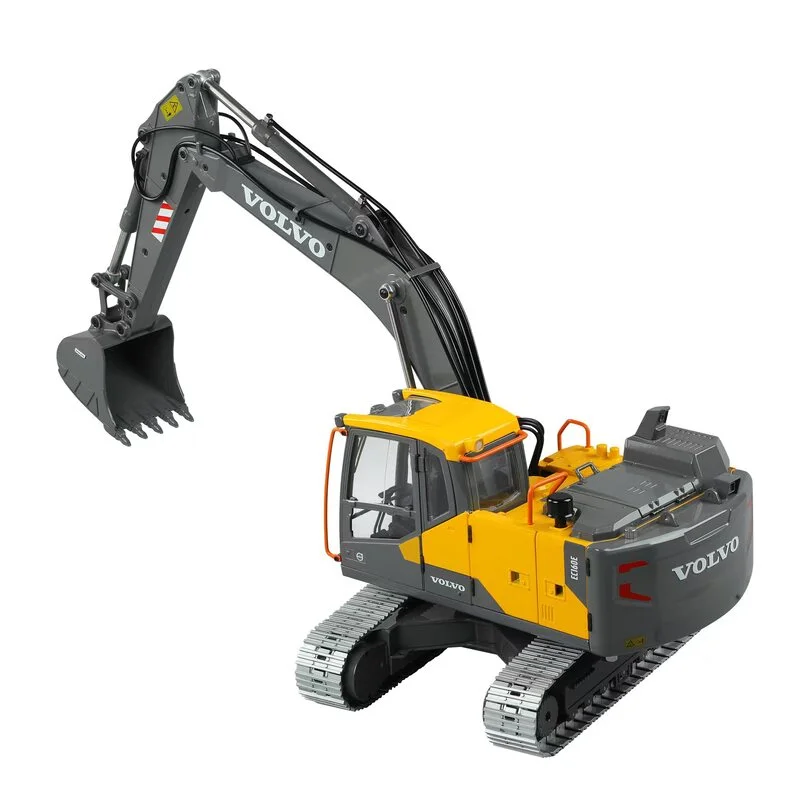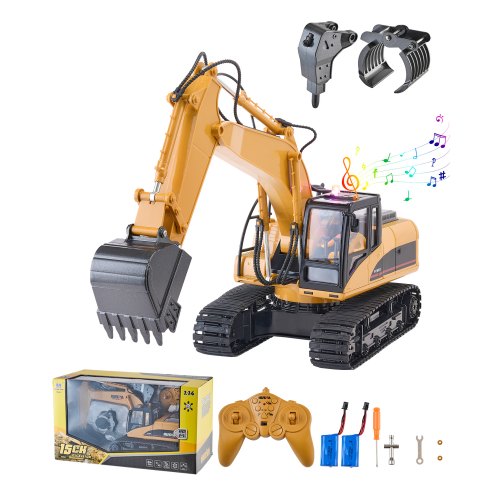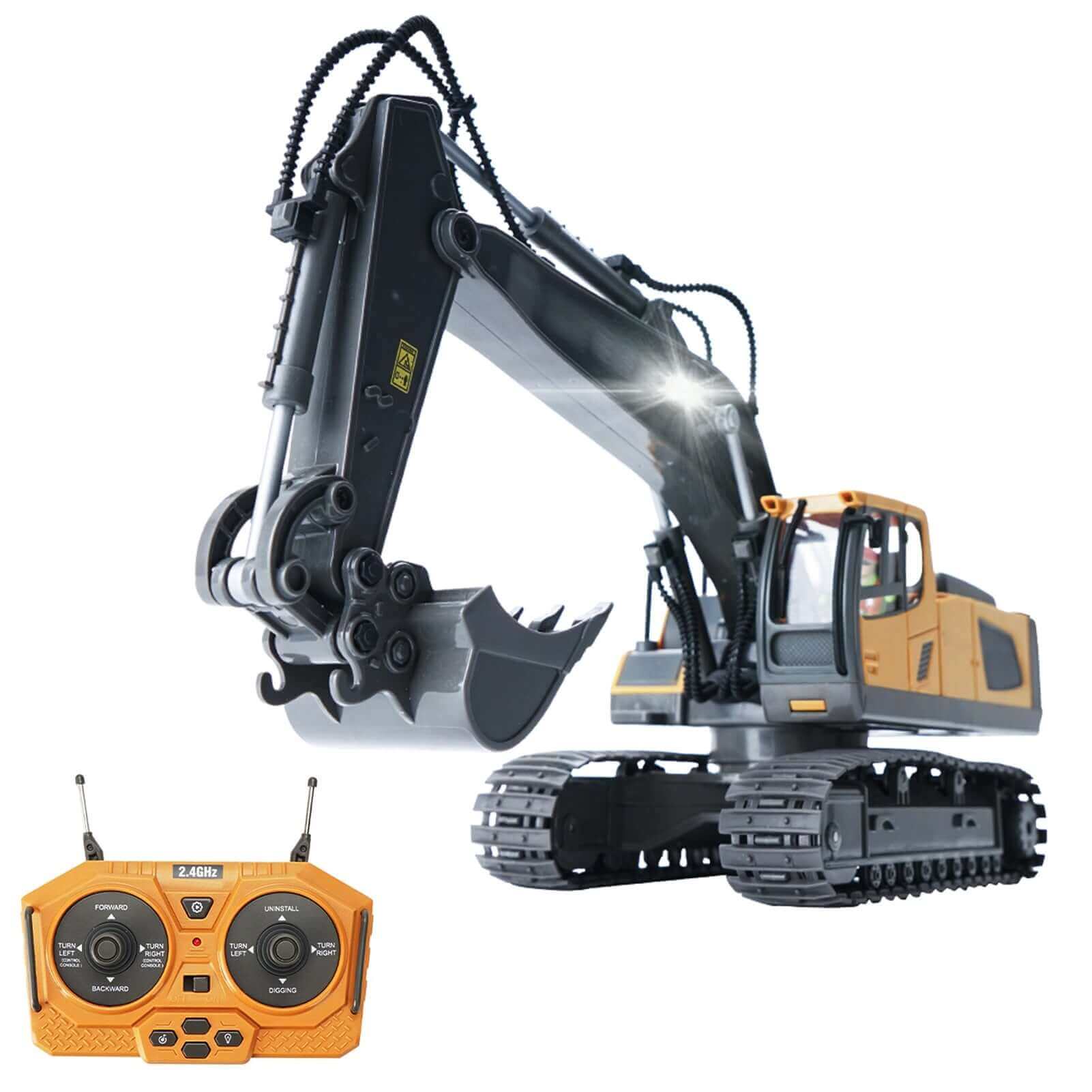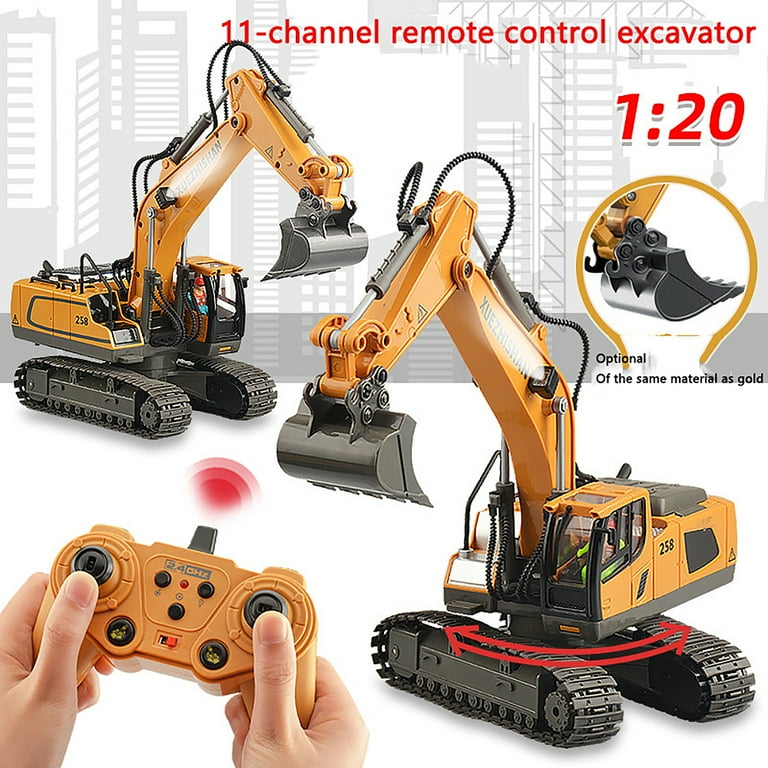Why the remote control excavator Is a Revolution in Modern Construction
Wiki Article
The Crucial Features of Excavator That Make Things a Must-Have Tool
Excavators are essential in the building and construction and landscaping sectors. Their versatile add-ons enable a series of tasks, from excavating to demolition. Furthermore, they flaunt remarkable digging deepness and reach, powered by durable engines. Operator convenience and compact styles boost use in numerous settings. Nonetheless, what genuinely sets excavators apart are their innovative hydraulic systems and sturdiness. Comprehending these attributes can clear up why they are thought about essential tools on any kind of work site.Versatile Attachments for Improved Performance
Excavators are powerful makers on their own, the enhancement of flexible attachments significantly boosts their capability. These add-ons change a standard excavator right into a multi-purpose tool, ideal for a selection of jobs. Buckets, as an example, been available in numerous shapes and dimensions, enabling operators to dig, scoop, and move products effectively. Hydraulic thumbs can be included for boosted gripping and handling of bulky things, such as logs or rocks.Furthermore, specialized add-ons like breakers and augers permit for drilling and demolition job, broadening the excavator's energy on building sites. remote control excavator. Grapples are another option, perfect for moving and sorting particles. This adaptability not only enhances efficiency but also decreases the demand for numerous makers, saving time and expenses. By gearing up excavators with the best accessories, drivers can tackle varied jobs, making them crucial in the building and construction industrySuperior Excavating Depth and Get To
Excavators are created with remarkable digging deepness and reach, enabling them to maneuver in limited areas and access hard-to-reach locations. This ability is essential for various building and construction and excavation jobs, where traditional machinery might fail. With adjustable boom arms and extendable tracks, excavators can conveniently navigate uneven terrain while preserving stability.The excavating deepness can differ substantially amongst versions, commonly varying from 10 to 25 feet, depending on the design and function. This feature enables drivers to excavate foundations, trenches, and various other deep structures successfully. Additionally, the reach of an excavator enables exact digging and material handling without rearranging the maker frequently, conserving time and labor costs.Ultimately, the superior excavating depth and reach of excavators make them crucial for experts seeking to finish intricate jobs with precision and efficiency. Their convenience enhances efficiency on work sites, showcasing them as a vital tool in contemporary building and construction.Powerful Engine Performance

Effective engine efficiency plays a pivotal function in the abilities of an excavator when it comes to efficiency and productivity on building and construction sites. A robust engine produces substantial horsepower, allowing the machine to tackle heavy-duty tasks easily - remote control excavator. This strength equates right into faster cycle times, allowing drivers to full jobs extra quickly.Additionally, effective engines provide the required torque to take care of tough surfaces and differed tons, guaranteeing that the excavator can do effectively under different conditions. Whether it is raising, excavating, or moving materials, the engine's efficiency directly impacts the total functional efficiency of the machine.Furthermore, improvements in engine innovation have resulted in enhanced fuel efficiency, lowering functional costs while keeping power result. Inevitably, the engine's efficiency acts as the backbone of an excavator, affirming its status as a vital device in the building and construction sector
Advanced Hydraulic Equipments

Boosted Lifting Ability
A substantial improvement in lifting ability can be connected to sophisticated hydraulic systems found in modern-day excavators. These systems utilize high-pressure liquid to produce greater pressure, allowing operators to raise heavier loads effortlessly. The design behind these hydraulics warranties peak efficiency, offering an excellent power-to-weight ratio that improves overall performance. Therefore, excavators can take on demanding jobs, such as raising big materials or devices, without compromising stability. In addition, the robust layout of hydraulic components adds to enhanced resilience and integrity, making them suitable for numerous building environments. This boosted lifting ability not just decreases the moment required for jobs yet also lessens the demand for extra machinery, confirming vital for both efficiency and cost-effectiveness in the building and construction market.Improved Precision Control
Typical excavators frequently had a hard time with accuracy, modern hydraulic systems have transformed control mechanisms, making it possible for operators to implement tasks with exceptional precision. These advanced systems utilize proportional control valves that enable smoother and extra receptive activities, considerably decreasing the margin for error. Operators can now finely tune the excavator's movements, making it much easier to browse limited rooms and handle delicate products. Boosted responses systems better inform drivers of real-time efficiency, guaranteeing excellent sychronisation in between the maker and operator. This increased precision not just boosts effectiveness however likewise enhances safety on work websites, lessening the danger of mishaps. Because of this, modern excavators equipped with innovative hydraulic systems are very useful devices for building and excavation projects requiring thorough accuracy.Operator Convenience and Exposure
Operator comfort and visibility are crucial components in the design of modern excavators (remote control excavator). Features such as ergonomic seat design, boosted presence choices, and efficient control formats considerably improve the driver's experience and efficiency. Prioritizing these aspects assurances that operators can function effectively and securely in different problemsErgonomic Seat Design
Convenience and visibility are vital in excavator design, with the ergonomic seat playing a necessary duty in enhancing the operator's experience. An ergonomic seat is engineered to support the driver's body, decreasing fatigue during long hours of operation. Flexible features, such as seat elevation, back-rest angle, and lumbar assistance, satisfy private choices and promote ideal pose. These adjustments improve convenience and enable the operator to keep concentrate on tasks without pain. Additionally, a properly designed seat can supply better lateral assistance, allowing for smoother handling when the excavator is in procedure. This thoughtful design not just boosts efficiency yet also adds to total safety, making certain that operators can do their duties successfully and efficiently.Improved Presence Features
The style of an excavator expands beyond simply the seat, with enhanced presence attributes playing a considerable role in driver comfort and total security. Huge windows and tactically located mirrors offer drivers with a clear view of their environments, minimizing blind areas. This layout consideration allows for better spatial understanding, which is important in busy workplace. On top of that, several excavators include rearview cameras and progressed monitoring systems that aid drivers in steering limited spaces. The assimilation of these visibility includes not just advertises security but also decreases operator fatigue by enabling simpler tracking of workplace. Inevitably, boosted visibility adds to extra reliable operations and helps guarantee that excavators can execute their jobs successfully and securely.Control Format Effectiveness
While maneuvering facility job sites, an efficient control format considerably boosts both driver comfort and visibility. A properly designed control arrangement guarantees that operators can access crucial features with marginal effort, minimizing fatigue throughout long hours. Ergonomic joystick placements and user-friendly button arrangements enable seamless procedure, making it possible for drivers to keep concentrate on the task handy. Additionally, clear presence of both the job location and the control panel is important for safety and security and precision. Modern excavators typically include flexible seating and control settings to suit various operator choices, even more boosting convenience. Ultimately, a thoughtfully created control layout not just boosts productivity yet likewise fosters a safer working setting by allowing drivers to respond quickly to changing conditions.Compact Style for Urban Environments
As city building and construction websites commonly face room restraints, a compact layout comes to be important for excavators operating in these environments. These makers are crafted to browse limited areas, enabling effective ability to move in congested task websites. A minimized footprint allows them to work very closely to existing structures, lessening disruption and taking full advantage of productivity.The compact layout commonly includes shorter tracks and a tighter turning span, facilitating procedure in narrow streets and restricted locations. Moreover, lightweight products contribute to relieve of transportation, making it simpler to move the excavator from one place to another within the city landscape.Additionally, several small excavators are outfitted with features such as functional add-ons and extendable arms, boosting their functionality while maintaining a small size. This versatility permits drivers to take on a variety of tasks, from excavating to demolition, all while fitting perfectly into the constraints of metropolitan environments.
Toughness and Maintenance Considerations
Resilience stands as a vital aspect in the efficiency and long life of excavators, specifically in requiring metropolitan atmospheres. These devices undergo rigorous conditions, including varying soil types, severe temperature levels, and high-frequency usage. Premium materials and robust construction are required for making sure that excavators can hold up against these difficulties without compromising functionality.Regular maintenance is just as essential in maintaining resilience. Arranged evaluations, timely oil adjustments, and the replacement of worn parts contribute considerably to an excavator's life expectancy. Operators should additionally take note of hydraulic systems, tracks, and undercarriages, as these components frequently bear the impact of wear and tear.Investing in sturdy excavators with comprehensive upkeep plans enhances dependability and lessens downtime, inevitably leading to enhanced performance on building websites. Comprehending the interaction between resilience and upkeep is crucial for any person thinking about the purchase of an excavator for urban jobs.Frequently Asked Questions
How Do Excavators Contrast to Various Other Construction Tools?
Excavators stand out among building and construction equipment as a result of their versatility, enabling tasks such as grading, training, and digging. Contrasted to others, their hydraulic capabilities offer better performance and power, making them indispensable on numerous job websites.What Safety And Security Includes Are Included in Modern Excavators?
Modern excavators integrate various safety and security features, including rollover security systems, alarms, and advanced exposure enhancements. These aspects interact to decrease dangers, making certain driver security while enhancing efficiency on construction websites and various other demanding atmospheres.
Can Excavators Be Made Use Of in Winter Season Conditions?
Excavators can undoubtedly be used in winter months problems, provided they are equipped with ideal winter months accessories and precautions are taken. Proper maintenance and adjustments enhance their performance, guaranteeing effective operation regardless of challenging weather condition scenarios.What Is the Ordinary Life-span of an Excavator?
The typical lifespan of an excavator usually ranges from 7,000 to 10,000 hours of procedure. This period can greatly depend on upkeep techniques, running conditions, and the details design's toughness and style functions.Just how Do I Choose the Right Excavator Size for My Project?
Picking the ideal excavator size entails evaluating project extent, website conditions, and product types. Take into consideration variables like reach, deepness needs, and weight capability to assure optimal efficiency and safety and security throughout procedure. Dimension issues significantly in job success. Furthermore, the reach of an excavator permits for precise excavating and material handling without rearranging the machine regularly, saving time and labor costs.Ultimately, the exceptional excavating depth and reach of excavators make them indispensable for professionals seeking to finish complex tasks with precision and efficiency. Convenience and exposure are vital in excavator layout, with the ergonomic seat playing a necessary role in improving the driver's experience. The layout of an excavator expands past just the seat, with improved exposure functions playing a substantial function in operator convenience and overall safety and security. Modern excavators frequently integrate flexible seating and control settings to fit various driver preferences, additionally improving remote control excavator convenience. Lightweight products add to reduce of transportation, making it simpler to relocate the excavator from one place to another within the urban landscape.Additionally, lots of small excavators are equipped with functions such as extendable arms and versatile attachments, enhancing their functionality while keeping a small dimension.Report this wiki page